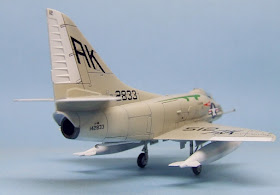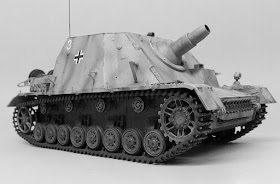The Airfix 1:72 A-4B Skywawk (A03029) is the first Skyhawk
I’ve done since I was a kid – and that one, some 44 years ago, was also an
Airfix, the ancient-tool original! I’ve wanted to add those classic Douglas
lines to my display case for a long time, and the new Airfix seemed an
inexpensive place to start.
This is a nice kit to put together for the most part, but
can bite you here and there. Alignment is generally fine but there were gaps at
the wingroots and intakes. The former I dressed using white glue and capillary
action, which seemed to work quite well, while the latter received traditional
filler, though the repair is by no means invisible. The canopy fit is fair but
can wander around in terms of seating the windscreen, while the main hood is
too deep – it stands high at the rear hinges, as if designed to be displayed in
the open position. There are delicate and fiddly parts, the landing gear
especially, and I had to take a few days break to let my frustration settle
down before resuming the job. The secondary strut on the nose gear snapped on
the sprue and was simply omitted, in the interests of sanity.
Paintwork is MM Acryl Gull Gray over Tammy flat white, with
Microscale Satin for the lustre. The decals are very good, but large ones grabbed
very fast, resulting in the loss of one of the large NAVY titles – I’ll replace
it next time I do one of these kits. Areas where multiple markings lie close
together are served by single decals, which is a good idea, except that with
the grab of these thin, lovely printings I dare not even try them – I cut away
the modex numbers from the front insignia and applied them separately. The same
would likely work for the rear flank decals – separate the elements and maybe
they’ll slip better.
There are a number of omissions in this build – mine, more
then the company’s. There is no decal for the “barbershop pole” effect on the
arrester hook, and after attempting to cannibalise strip decal, which shattered
at the first attempt, I dropped the hook into the receiver without glue so I
can come back to it at a later date if the means comes to hand. Likewise the
red edges of the gear bay doors are ignored – way too hard to freehand paint
and I’ll need strip decals of some sort (reliable ones…) before I try. The
intake warning markings are painted freehand around the curve (the sheet
provides straight decals for them, which must be some sort of hobby company
joke), and masking the correct narrower area for brush painting simply did not
work. So it was brushed up to the adjoining panel line, and that was as good as
it was going to get.
I’m more or less amazed that the landing gear is actually
strong enough to hold the model up, but it seems to be. I had visions of its
collapsing once the tanks were on, but superglue seems to have pinned
everything up well enough. The Eduard masks for the canopy were their usual breeze to use, and their usual frustration when they pulled up both paint and decals as they came off. There are times I wonder why I bother to use them when the result is so shoddy -- then I imagine trying to hand paint canopy struts and I remember why.
Overall, a good model that looks the part on the shelf, but
I’m reminded yet again that 1:72nd scale is a real trial, and I
prefer 1:48th – so long as there’s somewhere to put the finished
article. While doing this one I had the urge to grab a late-tool F-16 in the
larger scale and just do it, but sense prevailed. Until that fabled new display
case puts in an appearance, I must restrain my urge to build bigger!
Cheers, Mike














